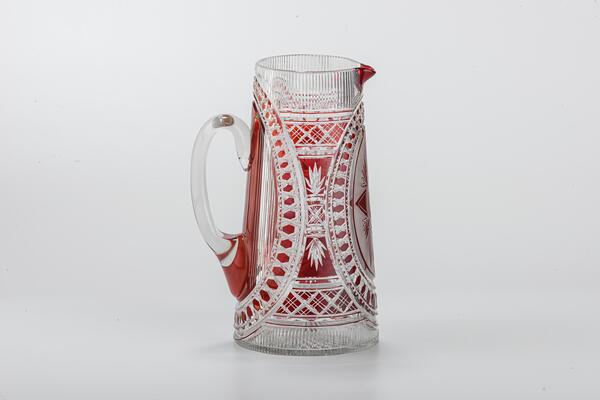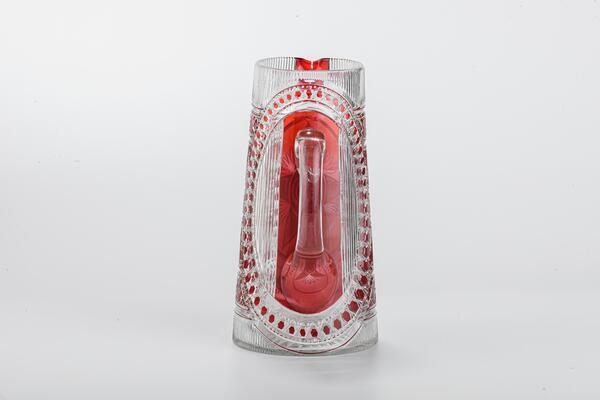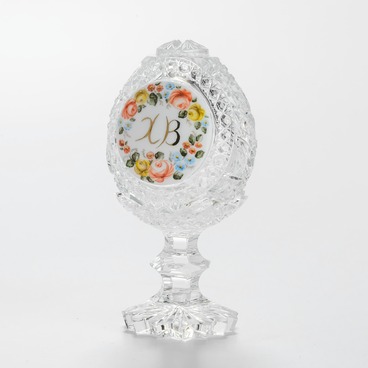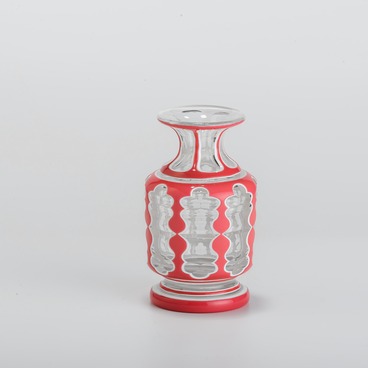In the 1920s, the Red Giant factory was going through hard times. The new Soviet state invested almost all the funds into the development of heavy industry and could not pay enough attention to the art of glassmaking.
High-quality raw materials from remote regions were no longer delivered to the factory, and it even became necessary to use local sand for melting glass. Necessary dyes were missing too. The glass factory was mainly commissioned to produce lamp glass. A few tableware items were only a small part of the main production.
During that period the glass industry was saved only by craftsmen whose professionalism was shaped by the traditions of the Nikolsko-Bakhmetevsky factory. Thanks to them, the products made of colorless, rather low-quality glass with a modest decor still had a graceful shape.
In the 1920s, proletarian symbols — a five-pointed star, a sickle and a hammer — became an almost indispensable element of any decor. Since the Middle Ages, the hammer has been a recognizable emblem of various types of craft. Some images featured two crossed hammers, sometimes it was a hammer and a pickaxe, a wrench or some other tool. Since the second half of the 19th century, this image became a symbol of the Western European proletariat, and then of the revolutionary movement. The sickle also appeared in Russian heraldry before 1917 as the most traditional tool of peasant labor, a symbol of harvest and reaping.
The hammer and sickle emblem was proposed by the Moscow artist Evgeny Kamzolkin for May Day 1918, and it was instantly accepted by the Soviet state. The pattern became ubiquitous: plates and tumblers, bowls and vases, creamers and wine glasses were decorated with this “star” motif. Sometimes ears of wheat, cereals, and wild flowers were added to the main image.
This pitcher is a vivid example of this trend. It is decorated with a pattern traditional for the 1920s: thin vertical cuts, ribbons, a medallion with a star, a hammer and a sickle, matte inscriptions “USSR” and “1929”, cross cuts, horizontal stripes and bushes. The only distinctive feature of the pitcher is that it was made in two-layer glass — colorless and red “copper ruby” — which was rare for that time.
High-quality raw materials from remote regions were no longer delivered to the factory, and it even became necessary to use local sand for melting glass. Necessary dyes were missing too. The glass factory was mainly commissioned to produce lamp glass. A few tableware items were only a small part of the main production.
During that period the glass industry was saved only by craftsmen whose professionalism was shaped by the traditions of the Nikolsko-Bakhmetevsky factory. Thanks to them, the products made of colorless, rather low-quality glass with a modest decor still had a graceful shape.
In the 1920s, proletarian symbols — a five-pointed star, a sickle and a hammer — became an almost indispensable element of any decor. Since the Middle Ages, the hammer has been a recognizable emblem of various types of craft. Some images featured two crossed hammers, sometimes it was a hammer and a pickaxe, a wrench or some other tool. Since the second half of the 19th century, this image became a symbol of the Western European proletariat, and then of the revolutionary movement. The sickle also appeared in Russian heraldry before 1917 as the most traditional tool of peasant labor, a symbol of harvest and reaping.
The hammer and sickle emblem was proposed by the Moscow artist Evgeny Kamzolkin for May Day 1918, and it was instantly accepted by the Soviet state. The pattern became ubiquitous: plates and tumblers, bowls and vases, creamers and wine glasses were decorated with this “star” motif. Sometimes ears of wheat, cereals, and wild flowers were added to the main image.
This pitcher is a vivid example of this trend. It is decorated with a pattern traditional for the 1920s: thin vertical cuts, ribbons, a medallion with a star, a hammer and a sickle, matte inscriptions “USSR” and “1929”, cross cuts, horizontal stripes and bushes. The only distinctive feature of the pitcher is that it was made in two-layer glass — colorless and red “copper ruby” — which was rare for that time.





